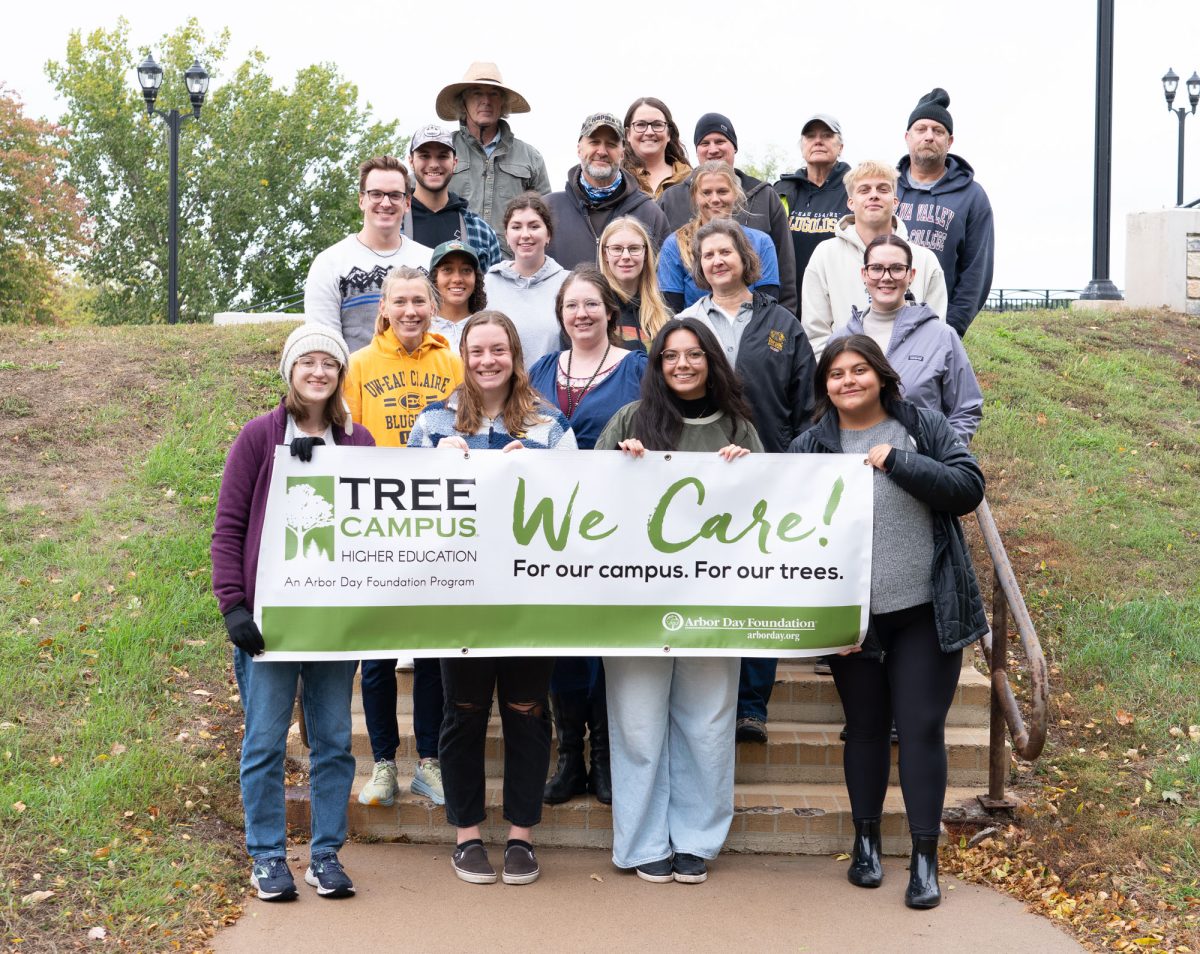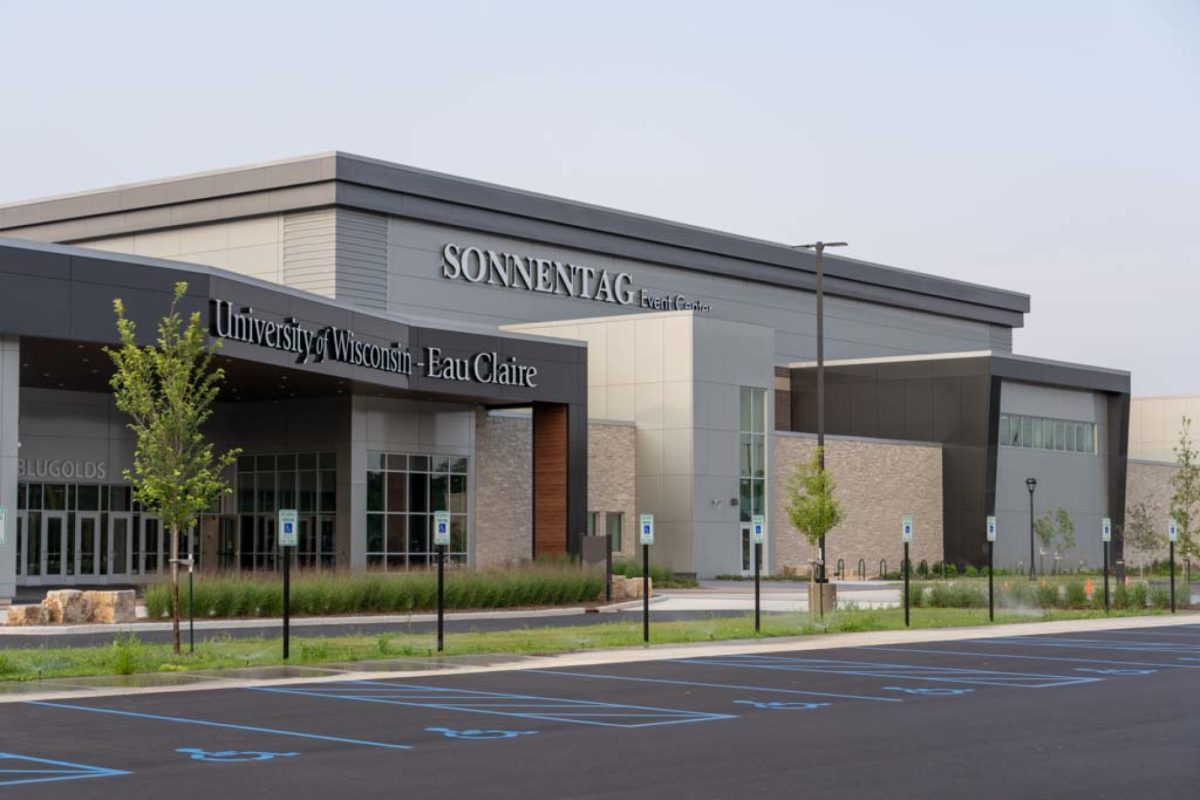It was a blustery morning on Friday, Oct. 6 when a group gathered in front of Haas Fine Arts Center for a tree-planting Arbor Day event. The sky was just beginning to bruise as the first few raindrops plummeted to the ground.
Members from UW-Eau Claire’s Student Office of Sustainability and Equity in Student Matters commissions collaborated with the campus Grounds Department to plant five new trees on the lawn surrounding Haas.
The event was part of a Tree Campus USA endorsement award and sponsored by the National Arbor Day Foundation.
Matthew Staudenmaier, Forestry Department supervisor for the City of Eau Claire, joined the group to share more about the tree-planting process as well as dendrology in Wisconsin.
“We usually hold at least one Arbor Day event annually. Last fall, we did buckthorn removal,” Staudenmaier said.
Staudenmaier said Eau Claire is unique in that the city is home to two Tree Campus USA campuses: UW-Eau Claire and Chippewa Valley Tech.
“UW-Eau Claire was actually one of the first in the country to be recognized by Tree Campus USA,” Staudenmaier said.
Landscape architect Daria Hutchinson said the group was reinstalling sugar maple and American hornbeam trees, both of which are native to Wisconsin.
Staudenmaier said these species will replace the ash trees that previously stood near Haas and were killed by the invasive Emerald Ash Borer.
The group split into five sections and began planting. The young trees were contained in large pots with plastic tubing surrounding the trunks.
John Moynaham has worked as a campus gardener for about five years and has been involved in the installation of many native tree varieties during that time. Moynaham said when picking out trees at a nursery, it’s best to look for a branching root system.
“When you dig the hole for planting, you’ll want it to be one and a half to two times the width of the root system,” Moynaham said. “That space will give the roots a good opportunity to spread.”
The groups removed the trees’ plastic tubing and took the trees out of their pots.
Staudenmaier demonstrated to students what it means for a tree to be “root-bound.”
“Roots will grow to fit the shape of the pots because they’re trying to seek oxygen,” Staudenmaier said. “It’s best for newly planted trees to focus their energy on root growth at first. If you don’t have good root structure, you’re ultimately not going to see great results.”
Staudenmaier discussed potential harm to trees which can be caused by issues with their initial planting. For instance, Staudenmaier said, the depth at which trees are planted is very important.
“If you see older trees growing straight out of the ground, that means they were planted too deep. That will make them prone to other pathogens. On the flip side, planting them too shallow could cause them to die off more quickly,” Staudenmaier said.
According to Staudenmaier, certain roots left sticking out of the soil can graft to the vascular tissue of a tree and be harmful in that way.
Before placing the trees in the ground, the groups cut vertically to disrupt the bound-up roots and allow for more spread. Next, the surrounding soil was thoroughly watered.
“I like to fully drench the soil while planting, making it muddy. This will help get rid of air pockets,” Staudenmaier said. “The water also needs to go deep; it’s not helpful to only strike the base layer of soil. Water is really the magical ingredient here.”
As students helped fill in the space around each tree, Staudenmaier described some of the care necessary for trees as they mature. He used human education as an analogy for tree growth.
“If you stopped your schooling immediately after kindergarten and were never taught anything else, you would not be a well-developed individual. It’s the same for trees; the care cannot just stop after they’ve been planted,” Staudenmaier said.
Staudenmaier explained that things like pruning and thorough watering are important as trees continue to grow.
“You want to allow for slow growth; if they shoot up too quickly, susceptibility to pathogens will increase,” Staudenmaier said.
After each of the five trees had been planted, cookies and refreshments were distributed to event-goers before they departed.
Wojahn can be reached at wojahnal7429@uwec.edu.















